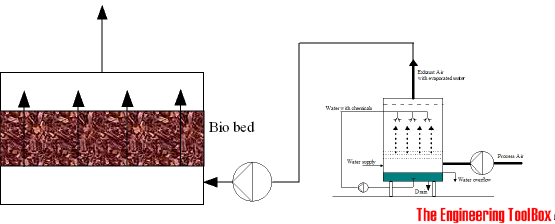Scrubber Basics
In a wet scrubber process air is drawn through a mist of water made by spray nozzles, then through separators where water droplets with dust and particles are removed.
Air scrubbers are commonly used in process-air applications to eliminate potentially harmful dust and pollutants. A liquid, in general water added with active chemicals adapted to the process, is sprayed in to the air flow. Aerosol and gaseous pollutants in the air stream are removed by either absorption or chemical reactions with the water solution.
A schematic drawing of a typical spray nozzle scrubber configuration is shown below.

Water with chemicals are sprayed with high pressure through nozzles into the air flow. Some of the water evaporates, especially if the process-air is hot, and disappear with the exhaust. Water droplets are separated from the exhaust and re-circulated back to the water reservoir. Evaporated water is replaced by fresh water and chemicals. Dust and pollution products from the process are removed periodically through the drain.
Wet Scrubber Basic Configurations
The basic scrubber configurations are:
- Orifice scrubbers - air or gas velocity is increased through an orifice - increased turbulence atomize the water droplets
- Venturi scrubbers - air or gas velocity is increased through a venturi shape - increased turbulence atomize the water droplets
- Fiber-bed scrubbers - air passes through wet-laden fiber mats where mists are collected. Not suited if solid particles are present in the air since the fiber mats may plug
- Mechanical scrubbers - a mechanical driven rotor produces the fine water droplets in the air
- Impingement-plate scrubber - vertical scrubber with horizontal plates, air flows from bottom to top, water flows from top to bottom
- Spray nozzle scrubbers - water are sprayed with high pressure through nozzles to produce the droplets in the air
Typical Scrubber Data
- Cleaning efficiency: 70% of fine dust and 80% of coarse dirt
- Air velocity through the washer: 2 - 3 m/s
- Air flow pressure drop resistance: 50 - 140 N/m2
- Water pressure before nozzles: 100 - 170 kN/m2
- Water consumption: 0.45 - 0.55 l/m3 air (depends on the temperature of the process air)
Scrubber humidifying efficiency
Some industrial processes need more cleaning than a single scrubber can provide. In smell polluted processes, like exhaust air from fish meal or fish feed dryers, bio beds are commonly used. A bio bed, which is an organic organism, require process air with as little dust as possible and temperature and humidity within certain limits.

The humidifying efficiency of the scrubber may be expressed as:
μh = (t1 - t2) / (t1 - tw) 100% (1)
where
μh = scrubber humidifying efficiency (%)
t1 = initial dry bulb temperature (oC)
t2 = final dry bulb temperature (oC)
tw = initial wet bulb temperature (oC)
Scrubber Efficiencies
Typical nozzle scrubber efficiencies
- 60-70 % with one bank of nozzles downstream
- 65-75 % with one bank of nozzles upstream
- 85-100 % with two banks of nozzles
Note! Be aware that low temperature scrubbers can be a potential source for the Legionella disease. Special cleaning and disinfection precautions should always be taken when the temperature in the scrubber is in the "Legionella range".



